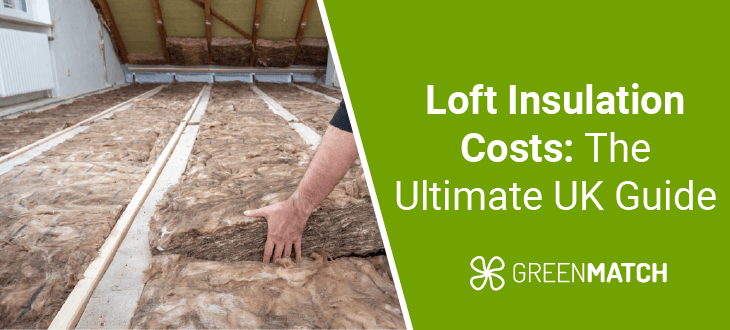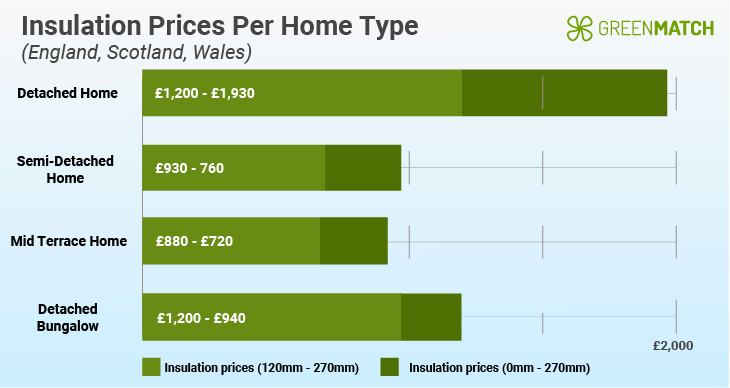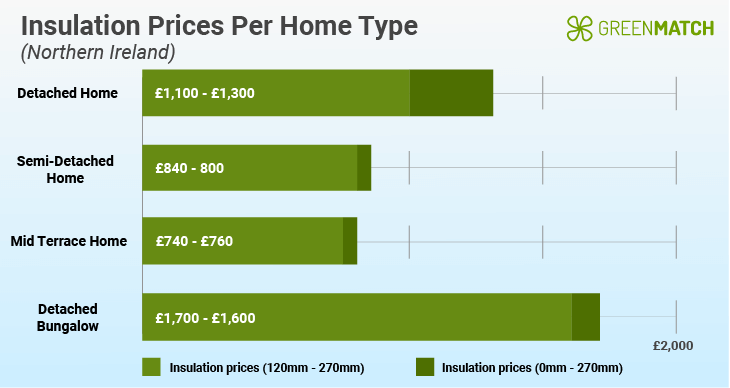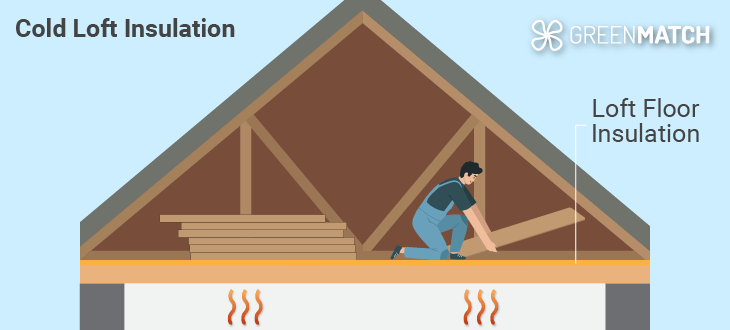Answer these simple questions and we will find you the BEST prices
Which type of solar quotes do you need?
It only takes 30 seconds
100% free with no obligation

Get Free quotes from insulation specialists near you

Save money by comparing quotes and choosing the most competitive offer

The service is 100% free and with no obligation
- GreenMatch
- Insulation
- Loft Insulation
- Loft Insulation Cost
Loft Insulation Cost Guide: Understanding UK Prices 2025


- Around 21% of all the CO2 emissions in the UK are produced by poorly insulated homes.
- Uninsulated lofts are responsible for up to 25% of a home's heat loss.
- In 2025, an average loft insulation cost for a standard UK 3-bedroom semi-detached home is around £930.
With only 12% of homes holding a C rating from the Energy Performance Certificate (EPC), poorly insulated homes are a problem far too common throughout the UK. In turn, plenty of homeowners are suffering from inflated energy bills, poor living standards, and chilly winters.
You might be wondering; does loft insulation make a difference? Loft insulation is one of the most worthy investments you can make for home improvement. With up to a quarter of heat loss reduction, loft insulation also boasts a quick payback period on your investment of just 3 years, a small price to pay for decades of effective home insulation.
If that’s not enough to celebrate already, here are just some of the perks you can expect:
- Reduced carbon emissions: UK housing has a bigger carbon footprint than all of the country's cars combined. This means staying at home creates more CO2 than driving a car! Loft insulation is a valuable energy efficiency upgrade that can cut your household emissions by 0.6 to 1 ton per year.
- Improved living standards: Poorly insulated homes are hard to maintain, leading to depleted savings, financial insecurity, and a high cost of living. Insulating your loft can save between £270 - £445 on your annual energy bills based on your property type.
- Better health and air quality: Poorly insulated homes are a breeding ground for dampness and mould, which can worsen your air quality and encourage illnesses, respiratory infections and asthma. According to the NIA, poor insulation-related illnesses cost the NHS around £2.5 billion in medical care every year.
- Boost property value: Homes that rate band C or higher in the Energy Performance Certificate (EPC) are much more attractive on the housing market. By insulating your home, you are raising the value of your investment.
In this guide, we will introduce you to everything you need to know about loft insulation costs, insulation materials, and the factors you need to consider before going ahead with a job.
Already set for loft insulation? Look no further than GreenMatch UK to take the weight of endless researching and vetting off your shoulders. By filling out our quick 30-second form, you can receive up to 3 free quotes for loft insulation tailored to your home's specifics. No hidden charges, no obligations. Click the button below to begin!
- Describe your needs
- Get free quotes
- Choose the best offer
It only takes 30 seconds



How much is loft insulation in the UK?
On average, a 3-bedroom semi-detached home in the UK can expect to pay up to £930 for full loft insulation. The cost to replace loft insulation may differ. However, your final costs will vary based on your loft size, insulation material, and whether the job was DIY or professional amongst other factors.
Regardless, there are plenty of loft insulation options available for all types of budgets, as well as government grants and schemes designed to assist households with financial difficulties.
In addition to these insulation grants, the 0% VAT on insulation in the UK is also available from April 1st, 2022, until March 31, 2027.
Investing in loft insulation brings significant energy bill savings for all types of properties. UK homes with insulated lofts can expect annual savings of up to £270 for semi-detached homes, and up to £445 for detached homes. In most cases, it will only take 3 to 4 years for your loft insulation investment to pay itself off.
Cost of loft insulation materials per m2
Loft insulation costs per m2 can vary based on your material of choice and its insulating effectiveness. With house insulation becoming widely popular throughout the UK, some insulating materials are in high demand, also affecting the overall costs.
In any case, there is a wide range of insulation materials on the market suited for all budgets and purposes. Generally, the more high-quality and effective the insulation material is, the higher the insulation cost.
Check out our full breakdown of the most common insulation materials, and the loft insulation cost per m2 (including installation) below:
| Material | Average cost (per m2) incl. installation |
|---|---|
| PIR Board | £5 – £15 |
| Fibreglass | £10 |
| Polystyrene (EPS) Board | £10 |
| Cellulose | £10 - £12 |
| Mineral Wool (Glass) | £13 - £17.5 |
| Sheep's wool | £17.5 - £22 |
| Mineral Wool (Rock) | £18.2 |
| Polyurethane Board | £21.5 |
An important consideration is that sound insulation roof materials tend to cost slightly different to thermal insulation materials, so it's best to check the differences if you are in the market for acoustic insulation instead.
Loft insulation costs per property type
A typical 3-bedroom semi-detached house in the UK could expect to pay around £930 for loft insulation, while this cost can go up to £1200 for detached homes. If you want to insulate a loft conversion, your cost may be higher.
Keep in mind that these costs are averages, and your final investment will depend on other factors such as your loft size, chosen insulation material, installation complexity, and whether you hire a professional or do the job DIY.
For a better picture of what you could expect, check out our summary of the average loft insulation costs per property type in England, Scotland, and Wales:

| Home style | Insulation prices (0mm - 270mm) | Insulation prices (120mm - 270mm) |
|---|---|---|
| Detached home | £1,200 | £930 |
| Semi-detached home | £930 | £760 |
| Mid terrace home | £880 | £720 |
| Detached bungalow | £1,200 | £940 |
Average loft insulation costs may slightly differ if you are based in Northern Ireland, so here is what you could expect:

| Home style | Insulation prices (0mm - 270mm) | Insulation prices (120mm - 270mm) |
|---|---|---|
| Detached home | £1,300 | £1,100 |
| Semi-detached home | £840 | £800 |
| Mid terrace home | £740 | £760 |
| Detached bungalow | £1,700 | £1,600 |
Labour costs
Labour costs in 2025 for loft insulation normally sit around £250 per day. This labour cost is for loft insulation alone, but there are often other small jobs that may need to be carried out to ensure the job is done correctly. We discuss this later in the article.
The labour costs of installation can also vary depending on your location. For example, professional installers based in London, or other central cities may charge a premium fee in comparison to rural areas and suburbs.
While a DIY installation can cost two to three times less than a professional installer, there are many benefits to working with an accredited company that can ensure the job is done properly and in line with government-backed standards and regulations.
What factors affect the loft insulation cost
As mentioned before, a few key factors can greatly influence your loft insulation costs. Addressing these beforehand can ensure that you have the best understanding of what to expect financially. Here’s what you should take into consideration:
- What’s your loft for?
Insulating your loft for storage or living purposes is a huge factor in which type of insulation you need. Storage lofts can get by with cold loft insulation (insulating the loft floor), while living space lofts require a more complex warm loft insulation which involves insulating the loft rafters, the inner walls of the living space, as well as glazing and draught-proofing any windows and skylights. The best loft insulation between rafters can differ from between loft floor joists.
- Is there existing insulation?
Lofts with previous insulation in place may just need to top up to the government-recommended thickness of 270mm insulation. This requires the existing insulation to be dry and in good condition, which can be assessed by a professional. For example, if you've used blown insulation in your loft that is still healthy, you can perhaps buy some bags of loose-fill to top it up.
- Any ongoing home issues?
Lofts suffering from dampness and draught are unsuitable for insulation projects as this risks damage to your home's structural integrity with rot and mould down the line. These issues need to be solved with a professional before an insulation project, which can affect your overall costs.
- Professional or DIY installation?
DIY installation may save you money in the short run, but a poor job can have repair bills piling up in the years to come. For this reason, it’s always recommended to work with a professional installer. Still, inevitably this will cost two to three times more than installing by yourself.
Loft for storage space
The best insulation for loft space that will not be used for living is cold loft insulation. Generally, cold loft insulation is cheaper and easier, costing around £930. This is an ideal approach for households planning to use their loft just for storage purposes. Cold loft insulation makes sure your home below the loft stays warm, but your loft itself will not be insulated.
Here’s how cold loft insulation is carried out:

- The loft floorboards are lifted, and 270mm of mineral wool (or similar sheet insulation) is added in between the joists.
- Then, a 50mm air gap is left between the insulation material and floorboards for ventilation.
- Once the insulation and loft legs are in place, the floorboards are added back and secured.
Most loft floors can’t accommodate the recommended space of 270mm insulation and a 50mm air gap, so you might need to purchase loft legs from a hardware store to raise the floor height. While cold loft insulation can be done by yourself, working with a professional will ensure that a quality job is carried out and that government recommendations are met.
Damp and leaks
Homes with ongoing draught and dampness issues must solve these problems before installing loft insulation. This is because loft insulation is just as good at trapping moisture as it is at trapping heat.
Draughty homes with loft insulation risk worsening the dampness, creating an ideal breeding ground for rot and mould. Working with a professional to draughtproof and ventilate your loft will ensure your insulation stays healthy as well.
The cost of loft draught-proofing is difficult to predict as it depends on the issue your loft is facing. However, there are a few DIY approaches you could take to help the issue:
- Chimney: Lofts with chimney access can benefit from a chimney pot cover installed from the outside of the home. This ensures less heat loss and can cost around £150 per chimney from most hardware stores.
- Loft hatch insulation: Lofts with a hatch entry can be sealed with draught-proofing strips around the opening to prevent draught. This should cost no more than £50 on average.
- Pipework: Pipes that go through floors and walls can leave an entry gap. These gaps can be sealed with a filler foam or paste which can easily be bought from a hardware store. The whole job can cost up to £50.
- Loft ventilation: Installing an extractor fan in your loft can better help regulate moisture buildup and promote ventilation, but it would only be suitable in cold loft insulation. An extractor fan and its installation can cost around £400.
- Walls and ceiling: Any small cracks in the inside of your loft can easily be filled in with a mortar paste or mix for around £100.
Accessibility to the loft
Lofts that are difficult to access or not structurally safe will require blown insulation to be installed by a professional company. This is done by using specialist equipment to manually blow fibre insulation through an opening into the loft space.
Blown insulation is very effective in insulating hard-to-reach areas and hidden crevices, but will cost significantly more than standard blanket insulation. Typically, a blown loft insulation cost is around £2,200 to £2,750 for a 3-bedroom semi-detached home.
Unexpected issues
Alongside the labour costs associated with standard loft insulation, there can sometimes be other side tasks that need to take place to ensure the job is done correctly.
Below we’ve summarised some of these potential extra costs you could expect:
| Extra job | Average costs |
|---|---|
| Electrical wire relocating | £250 per day |
| Pipework insulating (incl. materials) | £6 per metre |
| Loft reboarding (incl. materials) | £55 per m2 |
Keep in mind that not every loft insulation will require these smaller jobs to take place, but it is very likely. These costs would be in addition to your loft insulation cost, and not included in it.
What is the cheapest way to insulate your loft?
The cheapest loft insulation would be to carry out cold loft insulation when only your loft floor is insulated to keep the rest of your house warm. The downside is that your loft space itself remains uninsulated. You can make this job even cheaper by choosing to work with budget-friendly insulation materials and carry out a DIY installation.
A DIY loft insulation cost is usually three to four times cheaper than a professional installation. Cheap loft insulation like fibreglass can also be used to further reduce prices. This is a blanket material that is readily available, easy to handle, and even fireproof. It can be installed by laying sheets of fibreglass over and in between the floor joists before adding back the floorboards. Fibreglass insulation usually costs no more than £10 per m2 at most.
Remember, the government-recommended thickness of insulation is 270mm. It is also important to leave at least 50mm of an air gap between the insulation material and the floorboards to make sure no condensation builds up over time.
It’s important to know that fibreglass can be an irritant, and should not come into contact with your skin or be inhaled. If you plan to install DIY, wearing protective gear like gloves, goggles and a mouth cover can ensure you are safe when installing fibreglass insulation in your loft floor.
Can you get free loft insulation?
You can potentially qualify for free - or reduced cost - loft insulation in the UK through two key government-backed schemes that are currently active; The Great British Insulation Scheme and the ECO4.
The two main nationwide schemes currently active in the UK are:
- The Great British Insulation Scheme (GBIS): This scheme focuses on delivering a single insulation measure per each qualifying UK household based on their most critical need. This allows the scheme to expand its reach across the UK. This can also include a loft insulation grant for homes that lack it. The scheme is active until March 2026.
- ECO4: Slightly different in style, the ECO4 scheme puts energy providers as directly responsible for helping low-income and energy-inefficient households with a range of improvements and upgrades. This also includes loft insulation, but other avenues as well such as central heating, energy system repairs and more. The scheme is active until March 2026.
For both the GBIS and ECO4, homes with members on certain government benefits, or individuals who fall into low-income categories are highly likely to qualify. In addition, homes with a low Energy Performance Certificate (EPC) rating - generally below C - will likely qualify for assistance.
You can directly apply to the Great British Insulation Scheme through the relevant government portal, whereas the ECO4 scheme requires you to reach out to your energy provider to see if you qualify to benefit.
Get multiple quotes to secure the best loft insulation cost
If you’ve decided to go ahead with insulation for your home, it's recommended to get multiple quotes from a broad range of installers to ensure you get the best value for your money. This way, you have the best chance of not missing any loft insulation deals out there.
Why go ahead with professional loft insulation installers in the first place? Despite the higher costs, the benefits speak for themselves:

- Safer handling: Some insulation materials are hazardous, or even fatal if in contact with your skin, ingested or inhaled. Accredited installer companies are trained and equipped with industry safety gear that allows them to work with such materials safely.
- Quicker installation: A professional installer can handle the job of loft insulation in a fraction of the time it would take to carry out a DIY job. This in turn frees you from the headache of prolonged disturbance to your home environment.
- Better craftsmanship: While we are sure there are plenty of DIY experts out there, a professional installer is no doubt well versed in their profession. This is especially useful when addressing outstanding draught, dampness and structural issues in your home before a loft insulation job. A professional can ensure that your loft is prepared for insulation and that the job is carried out in line with government regulations.
Ready to insulate your home's loft? The next step would be to find the right installer for the job and get a loft insulation quote. This is easier said than done with the endless options out on the market, risking you to get stuck in an endless cycle of website research and phone call vetting. Luckily, GreenMatch UK can help take this burden off your shoulders.
Benefit from our wide-spanning network of professional installers right in your area by simply filling out our 30-second online form. In return, receive up to 3 free quotes tailored to your specific home needs, with no hidden costs or obligations involved. Click below to begin!
- Describe your needs
- Get free quotes
- Choose the best offer
It only takes 30 seconds



FAQ
An average loft insulation cost for a 3-bedroom semi-detached house in the UK is around £930 for a standard job. This value can differ based on your loft size, insulation material, and whether you install DIY or professionally, amongst other factors.
The UK government recommends a minimum thickness of 270mm of loft insulation for optimal effectiveness. Amongst other factors, some homes already have existing insulation in place which falls short of this thickness. If this insulation is dry and in good shape, you can simply top up your insulation to the optimal thickness for a fraction of the costs of starting from scratch.
You don’t necessarily need to remove old insulation. Some old loft insulation may still be dry, not compressed, and in good shape. It’s best to get your existing insulation assessed by a professional to determine whether it needs to be removed or not. Topping up existing insulation is always cheaper than starting loft insulation from the beginning.
You may be able to get a grant for loft insulation in some cases. The two nationwide grant schemes currently active in the UK are The Great British Insulation Scheme and the ECO4. Both offer free, or reduced-rate, loft insulation options for low-income and fuel-poor households that qualify to benefit.

Akif is a copywriter at GreenMatch since 2023. With a keen interest in community sustainability, green solutions and the role of digital media in identifying climate trends, he aims to hone in on his background in International Studies and Digital Media to provide a multidisciplinary approach to written content rooted in credible research and accuracy.
We strive to connect our customers with the right product and supplier. Would you like to be part of GreenMatch?

